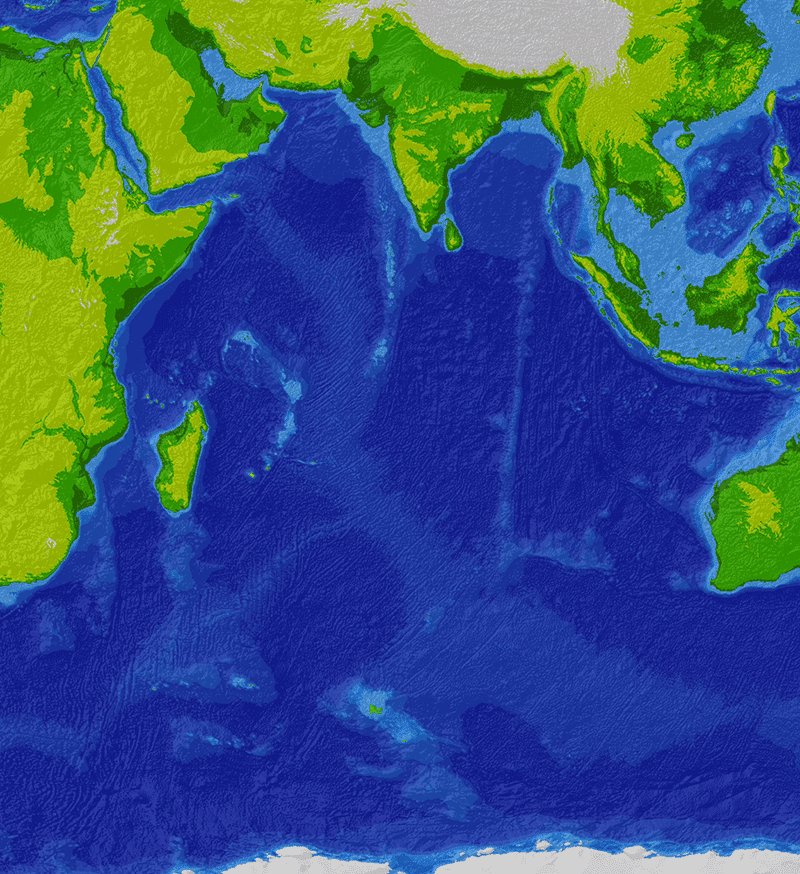
Indian Ocean Bathymetry
In the Indian Ocean, the amount of Precipitation differs greatly along its edges. While in the humid forests of Sumatra it rains heavily, the already dry East African region is affected by droughts. Researchers from the Biodiversity and Climate Research Center (BiK-F), the California Institute of Technology (CIT), the University of Southern California and the University of Bremen have observed that this bipolar cyclical climate phenomenon has persisted during the last 10000 years.
A pilot study published a few days ago in the "Proceedings of the National Academy of Sciences" sheds light on the climate system whose precipitation patterns have the greatest impact on global climate. Therefore, this study is of special interest to climate researchers.
The tropics play a crucial role in the global climate system, among other reasons because they are the origin of extreme climatic phenomena such as El Niño and monsoons. One of the most important regions of this type is the Indo-Pacific, in Southeast Asia since it is the largest source of atmospheric water vapor, as well as the largest receiver of rain on earth. Researchers have observed changes in precipitation offshore off the west coast of Indonesia over the past 24000 years in order to better understand local precipitation patterns and dynamics.
According to the researchers, it appears that the Indian Ocean dipole (Indian Ocean Dipole), has been a constant feature of the regional climate system for the last 10000 years. Among other evidences, anomalous rainfall patterns are observed in the eastern and western edges of the Indian Ocean, directly related. The precipitation dipole manifests itself in such a way that the higher the precipitation on the west coast of Indonesia, the lower the precipitation in East Africa and vice versa.
This new study, focused on the average amounts of precipitation taking periods of 30 years, shows that a similar pattern has been maintained during the last 10000 years. "These kinds of observations about the past can help to separate natural precipitation oscillations from those caused by man, considered very important in view of the ongoing climate change" comments Dr. Eva Niedermeyer (BiK-F), director of this study .
Niedermeyer and his research colleagues have worked with marine sediment samples taken offshore off the west coast of Sumatra at a depth of 481 meters. They focused on waxes found in land plantsIt is a layer on the surface of plants that protects them from dehydration and microbial attack, which remain in the sediments.
It is therefore possible to construct past precipitation changes by measuring the stable hydrogen isotopic composition in terrestrial plant waxes, since rain is the main source of hydrogen stored in plant material. This method thus increases direct measurement comparisons with very little temporal extension to long periods of the past.
With the end of the last ice age came rising temperatures and melting of the polar ice caps, which was accompanied by increased rainfall around Indonesia and in many other regions of the world. In contrast, the plant wax record observed in the study tells us that the large amounts of rainfall during the Last Glacial Maximum and the Holocene were quite similar.
The amount of rain that has fallen during the last 24000 years seems to be related to the level of exposure of the Sonda Platform and in particular to the specific topography of the western edge of the region, and not only to the limit climatic conditions of deglaciation. This was not what was expected, as based on previous studies it was assumed that the entire region was much drier during the last Glacial Maximum compared to current conditions, Niedermeyer concludes.
Although the study highlights that long-term changes in precipitation intensity are not always human-induced, it does not necessarily mean that current temporal anomalies along the countries of the edge of the Indian Ocean and in particular its are often not subject to human influence.
The Indian Ocean regions are experiencing increasing populations and adverse weather conditions in the future may lead to political and social conflict. A better knowledge of climatic phenomena and the hidden mechanisms that generate them in this area will help to increase the resolution of climate projections and prevent this type of conflict, anticipating the climatic repercussions.
Further information: Drought exacerbates the food crisis in the Sahel, Indonesia on the brink of collapse from torrential rains
Sources: Senckenberg